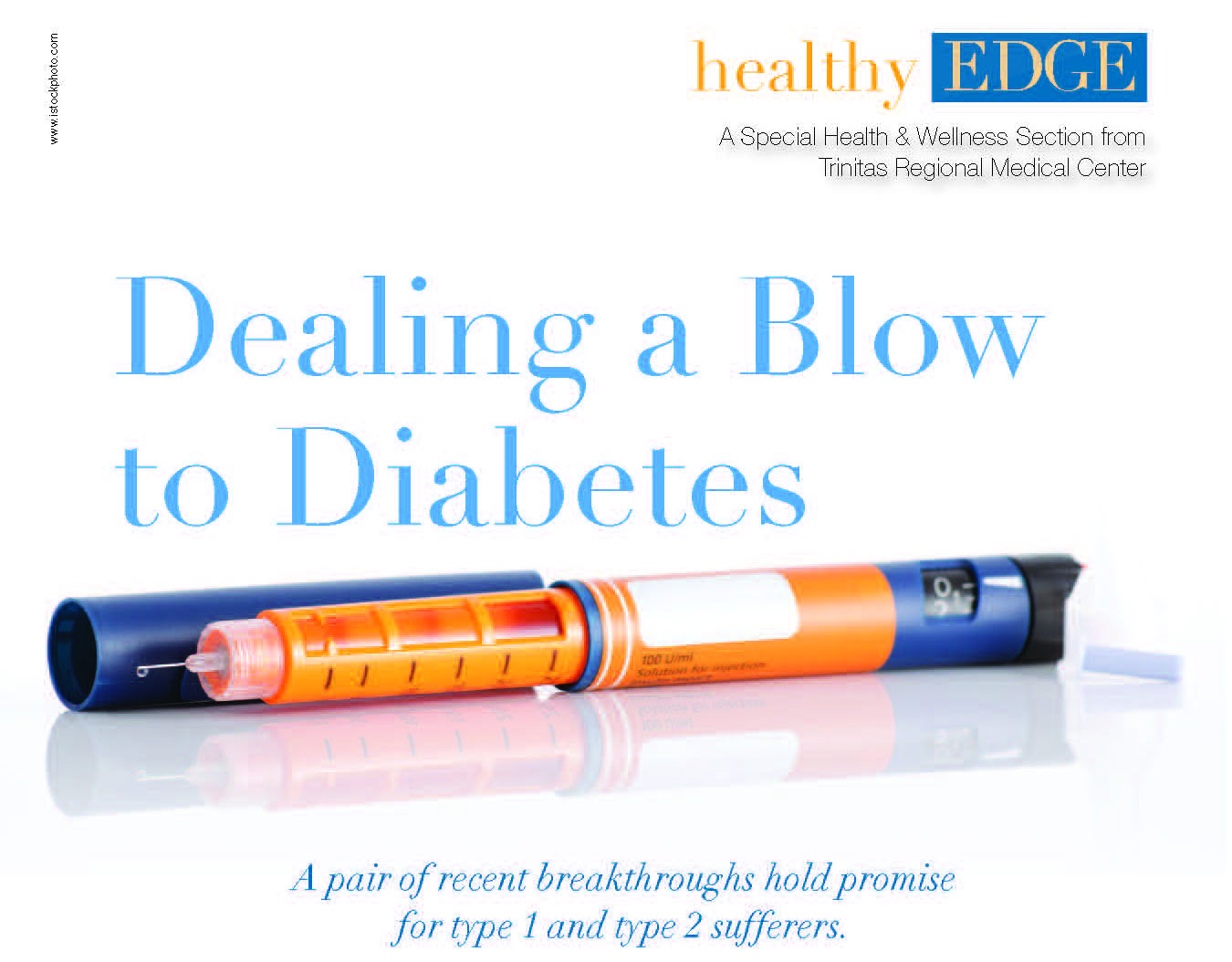A pair of recent breakthroughs hold promise for type 1 and type 2 sufferers
Americans may be living longer, but they’re also living sicker. Chronic and acute illnesses are on the rise, most notably diabetes. According to the American Diabetes Association (ADA), diabetes causes more deaths per year than breast cancer and AIDS combined. Diabetes affects 25.8 million Americans, about 8.3% of the population; it is the seventh leading cause of death in the U.S. and sixth in our state.

www.istockphoto.com
Not surprisingly, doctors have become hyper-vigilant when it comes to certain factors related to diabetic or pre-diabetic conditions. Nor should it come as a surprise that medical researchers and scientists around the world are working hard to find ways to prevent, manage and even cure this disease. In the last half of 2015 alone, several significant breakthroughs were reported. They ranged from new medical procedures to behavioral and dietary tweaks. Although a long-term magic-bullet cure is unlikely, the past year has produced some eye-opening results.
BioHub Breakthrough
A Texas woman named Wendy Peacock was introduced this summer as the first transplant recipient of a BioHub that mimics the pancreas. Peacock, who is in her 40s, was diagnosed with type 1 diabetes as a teenager and suffers from severe hypoglycemia unawareness—a dangerous drop in blood sugar that could cause her to faint without warning, or even slip into a coma while she’s asleep. With the implanted bio-engineered “mini-organ” she now has normal glucose levels and no longer needs to inject herself with supplemental insulin.
You Can Manage Your Diabetes!
 If you’ve just been diagnosed, or if you’ve been living with diabetes, quality medical care, encouragement and education can make a difference in your daily life.
If you’ve just been diagnosed, or if you’ve been living with diabetes, quality medical care, encouragement and education can make a difference in your daily life.
As an American Diabetes Association fully-accredited diabetes center, the Diabetes Management Center at Trinitas Regional Medical Center is a center you can trust to help you effectively manage your diabetes.

Ari Eckman, MD
Director, Trinitas Diabetes Management Center
Graduate of Johns-Hopkins University School of Medicine in Baltimore Specialist in Diabetes, Endocrinology & Metabolism committed to patient care and education
A respected staff of certified diabetes nurses, educators and nutritionists offer classes and one-on-one counseling
Quality medical care and attentive nursing support designed with you in mind to make diabetes a manageable part of your life
TRINITAS DIABETES MANAGEMENT CENTER
Medical Office Building, Suite 202 | 240 Williamson Street | Elizabeth, NJ | 908.994.5490THE HIGH COST OF HELPING
Statistics released by the ADA in 2013 on the cost of managing America’s diabetes problem were staggering:
- $245 billion: Total costs of diagnosed diabetes
- $176 billion for direct medical costs
- $69 billion in reduced productivity
A further breakdown of statistical evidence regarding diabetic-related expenses reveals:
- Inpatient hospital care (43%)
- Prescription medications to treat complications (18%)
- Anti-diabetic agents and diabetic supplies (12%)
- Physician office visits (9%)
- Nursing/residential facility stays (8%)
“As any type 1 knows, you live on a very structured schedule,” she said during a September press conference at the University of Miami Miller School of Medicine. “I do a mental checklist every day in my head: glucose tabs, food, glucometer, et cetera… Then I stop and say, ‘Wow! I don’t have to plan that anymore.’ Laying down at night and going to sleep and not having to worry about lows is something that is so foreign to me. It’s surreal to me. I’m still processing the fact that I’m not taking insulin anymore.”
The BioHub, which contains islet cells that restore natural insulin production, promises to be “a game-changer for millions of people,” according to Dr. Camillo Ricordi, who directed the project. Islet transplantation is not a new approach, but it has only been used in the liver until now.
The minimally invasive procedure required only three incisions, and doctors said they expected to perform 20 or 30 more at Miller School of Medicine in the coming year. And other diabetes centers will almost certainly join the BioHub trial.
Meanwhile, Peacock has no restrictions other than the diet and lifestyle a physician would recommend to any non-diabetic patient. “I feel like a great weight has been lifted,” she said, “I can breathe again.”
Type 1 diabetes is often referred to as Juvenile Diabetes, as it typically affects children and young adults. About one in every 600 children in the United States develops Type 1 diabetes, making it one of the most common chronic diseases in children. Symptoms usually occur during puberty, but it’s on the rise among younger children, some under the age of 5. Type 2 is often diet-related. It used to occur mainly in adults who were overweight and older than 40, however as childhood obesity rates rise, type 2 is on the rise among young people aged 10 and over. Per a 2012 CDC report, more than one-third of children and adolescents were overweight or obese. Childhood obesity has more than doubled in children and quadrupled in adolescents. Type 2 is not as life-threatening or dramatic as Type 1 at the time of diagnosis, but it can trigger serious long-term complications such as blindness, kidney disease, heart disease and limb amputation if left untreated.

www.istockphoto.com
THAT WOULD BE FALSE
According to the International Diabetes Federation, misconceptions about diabetes persist despite volumes of scientific and statistical evidence to the contrary:
- Diabetes only affects old people!
FALSE! Diabetes affects all age groups.
- Diabetes is not a killer disease!
FALSE! Diabetes is a global killer that is responsible for more than 4 million deaths a year. In fact, someone dies from diabetes-related complications about every 7 seconds.
- Diabetes predominantly affects men!
FALSE! Diabetes affects both men and women. In fact, diabetes today is on the rise among women along with a dramatic increase in Juvenile Diabetes.
- Diabetes cannot be prevented!
FALSE!Up to 80% of Type 2 diabetes is preventable by making healthy diet changes, increasing physical activity, and improving general lifestyle choices.
- Diabetes only affects prosperous societies!FALSE! Diabetes is a rising threat to all socio-economic groups, both in the US and globally.
Structure Settlement
Researchers looking at type 2 diabetes have begun to explore the way everyday foods are made. A study in England looked at what happens when the natural structure of dietary fiber is preserved during food production. The study’s findings, published in Diabetes Week, suggest that doing so slows the rise in blood sugar level following a meal. If this is indeed the case, it could lead to food products that look, feel and taste the same as existing products—but with an enzyme-resistant structure surrounding the starch, which would enable these foods to be digested more slowly.
The way starch is metabolized is relevant to a number of weight-related conditions, including type 2 diabetes.
The dietary fiber of grains forms a “protective” network of cell walls around starch. However, milling grains to produce different types of flour damages these cell walls, which enables the body to digest starch more quickly.
Study subjects were given a wheat porridge made of the identical ingredients, with one made of coarser particles and one finely milled. The people consuming the porridge with the larger particles showed 33 percent lower blood sugar levels after the meal, and insulin responses that were 43 percent lower. They also experienced less of a sugar crash.
The results strongly suggest that milling techniques that maintain the microstructure of grains such as wheat might be the key to a new wave of diabetic-friendly white bread, breakfast cereals and pasta.
Diabetes-related costs in the U.S. rose from $174 billion in 2007 to $245 billion in 2012—a 41 percent jump over 5 years. Medical expenses for diabetics, on average, are 2.3 times higher than for non-diabetics. Indirect costs such as absenteeism, reduced productivity, and disability claims cost untold additional billions. Within the scientific and medical communities, the disease is generally acknowledged as having reached pandemic proportions.
The hope is that a multinational, multifaceted approach to the problem will help turn those numbers around in the near future. Lifestyle modifications encouraging healthy eating habits and promoting physical activity can help lower risk of becoming of becoming obese and contracting related diseases. Ironically, the greatest challenge may not be the scientific hurdles, but instead the cultural ones. Humans are consuming more and exercising less. There may never be a cure for that.
Editor’s Note: Special thanks to Yelena Samofalov, MD of the Trinitas Pediatric Health Center for her input on this story. See page 66 for more from Dr. Samofalov on TRMC’s Eat Right Today! Program.





